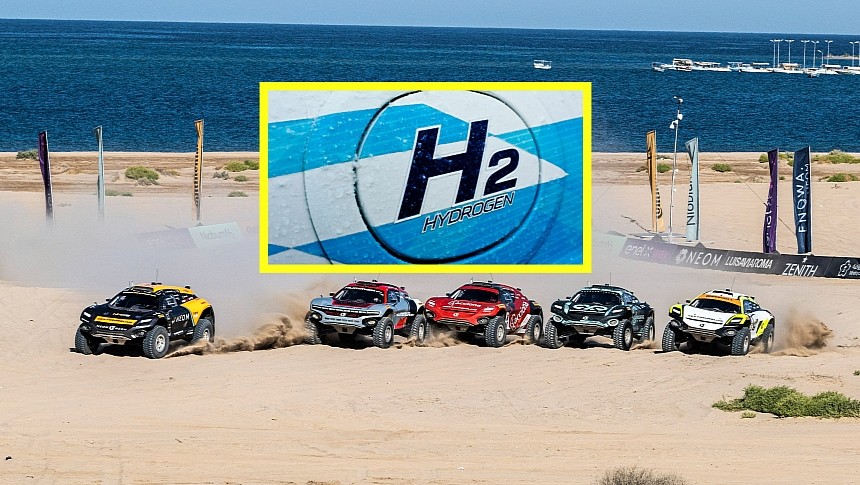Suppose you like racing, hydrogen-powered drivetrains, and SUVs. In that case, you might be happy to learn that Extreme E and the Fédération Internationale de l'Automobile (FIA) have taken the first step toward Extreme H – the first championship where fuel-cell SUVs will race in various off-roads environments to prove the technology is ready for general use. Here's what you need to know.
Extreme E is a little-known championship where fully electric SUVs fight for supremacy in various places worldwide that do not include asphalt surfaces. These vehicles look different from your average production-ready BMW X5 or Rivian R1S. They have been designed with some specifics in mind.
Called Odyssey 21, the 4,178-lb SUV has an output of 536 hp (400 kW). It can reach 62 mph in 4.5 seconds. Spark Racing makes them, and the racing SUVs include batteries provided by Williams Advanced Engineering. The base model can, however, be modified through partnerships with OEMs.
The vehicle's body is made from natural flax fiber, which sits on a niobium-reinforced steel alloy tubular frame. The same material is used for the crash structure and the roll cage.
The electric off-road racing event started in 2020 and is now on its third edition. Known racing drivers such as Sebastian Loeb, Lia Block, and Tanner Foust are actively involved in the motorsport, while F1 prodigy Lewis Hamilton, DJ Carl Cox, ex-F1 driver Jenson Button, and racing driver-turned-YouTuber Nico Rosberg are team owners.
But Extreme E also wants to show everyone that hydrogen-powered vehicles are safe and ready for some… Extreme racing!
The first step in this direction was taken on August 31, 2023, when FIA and Extreme E signed a Memorandum of Understanding (MoU) that established the steps the organizations would take toward the inception of Extreme H.
However, it's worth noting that the MoU is non-binding, meaning things could change at any moment, and the entire plan to bring forward off-road racing-ready fuel-cell SUVs could dissipate into the air.
If everything goes right, Extreme H could become a FIA-sanctioned event in 2025. A year later, in 2026, it should advance from a simple championship to a world championship. The latter would introduce strict sporting, technical, and financial regulations, but it would also attract notable sponsors.
Besides Formula 1 and Formula E, other FIA-sanctioned world championships are the Rally Championship, the Rallycross Championship, the World Endurance Championship, the Karting World Championship, and the World Rally Raid Championship.
The founder of Extreme E, Alejandro Agag, said signing this non-binding MoU with FIA is a "significant first step" that paves the way forward for launching a "ground-breaking" transition to hydrogen-powered racing.
"Once it achieves FIA World Championship status, Extreme H will continue what Extreme E started as a pioneering motorsport series, and we look forward to delivering another spectacular sporting product," added Agag.
FIA President Mohammed Ben Sulayem said Extreme H shows great potential and underlined that racing competitions "serve as excellent research and development platforms."
Fuel-cell vehicles (FCEVs) are considered by some as another alternative to gas-powered cars. FCEVs need a high-voltage battery to work. But unlike battery-electric vehicles (BEVs), hydrogen-powered cars do not need a large energy storage unit. In exchange, they require a pressurized hydrogen tank. The fuel cell combines hydrogen with oxygen via an electrochemical reaction. That's how water (and heat!) is created. No combustion occurs, and no exhaust fumes reach the air we breathe.
In the process, the hydrogen atoms are split into protons and electrons. The latter gets its own circuit and creates electricity, which is consumed by a motor to produce kinetic energy. At the same time, the former goes through the membrane (usually a polymer) that separates the anode and the cathode to meet with oxygen and, as a result, "merge" and become water (H2O).
Lastly, Extreme H was supposed to kick off in 2024. As things stand today, the first official race will happen in 2025.
Called Odyssey 21, the 4,178-lb SUV has an output of 536 hp (400 kW). It can reach 62 mph in 4.5 seconds. Spark Racing makes them, and the racing SUVs include batteries provided by Williams Advanced Engineering. The base model can, however, be modified through partnerships with OEMs.
The vehicle's body is made from natural flax fiber, which sits on a niobium-reinforced steel alloy tubular frame. The same material is used for the crash structure and the roll cage.
The electric off-road racing event started in 2020 and is now on its third edition. Known racing drivers such as Sebastian Loeb, Lia Block, and Tanner Foust are actively involved in the motorsport, while F1 prodigy Lewis Hamilton, DJ Carl Cox, ex-F1 driver Jenson Button, and racing driver-turned-YouTuber Nico Rosberg are team owners.
But Extreme E also wants to show everyone that hydrogen-powered vehicles are safe and ready for some… Extreme racing!
The first step in this direction was taken on August 31, 2023, when FIA and Extreme E signed a Memorandum of Understanding (MoU) that established the steps the organizations would take toward the inception of Extreme H.
However, it's worth noting that the MoU is non-binding, meaning things could change at any moment, and the entire plan to bring forward off-road racing-ready fuel-cell SUVs could dissipate into the air.
If everything goes right, Extreme H could become a FIA-sanctioned event in 2025. A year later, in 2026, it should advance from a simple championship to a world championship. The latter would introduce strict sporting, technical, and financial regulations, but it would also attract notable sponsors.
The founder of Extreme E, Alejandro Agag, said signing this non-binding MoU with FIA is a "significant first step" that paves the way forward for launching a "ground-breaking" transition to hydrogen-powered racing.
"Once it achieves FIA World Championship status, Extreme H will continue what Extreme E started as a pioneering motorsport series, and we look forward to delivering another spectacular sporting product," added Agag.
FIA President Mohammed Ben Sulayem said Extreme H shows great potential and underlined that racing competitions "serve as excellent research and development platforms."
Fuel-cell vehicles (FCEVs) are considered by some as another alternative to gas-powered cars. FCEVs need a high-voltage battery to work. But unlike battery-electric vehicles (BEVs), hydrogen-powered cars do not need a large energy storage unit. In exchange, they require a pressurized hydrogen tank. The fuel cell combines hydrogen with oxygen via an electrochemical reaction. That's how water (and heat!) is created. No combustion occurs, and no exhaust fumes reach the air we breathe.
In the process, the hydrogen atoms are split into protons and electrons. The latter gets its own circuit and creates electricity, which is consumed by a motor to produce kinetic energy. At the same time, the former goes through the membrane (usually a polymer) that separates the anode and the cathode to meet with oxygen and, as a result, "merge" and become water (H2O).
Lastly, Extreme H was supposed to kick off in 2024. As things stand today, the first official race will happen in 2025.








